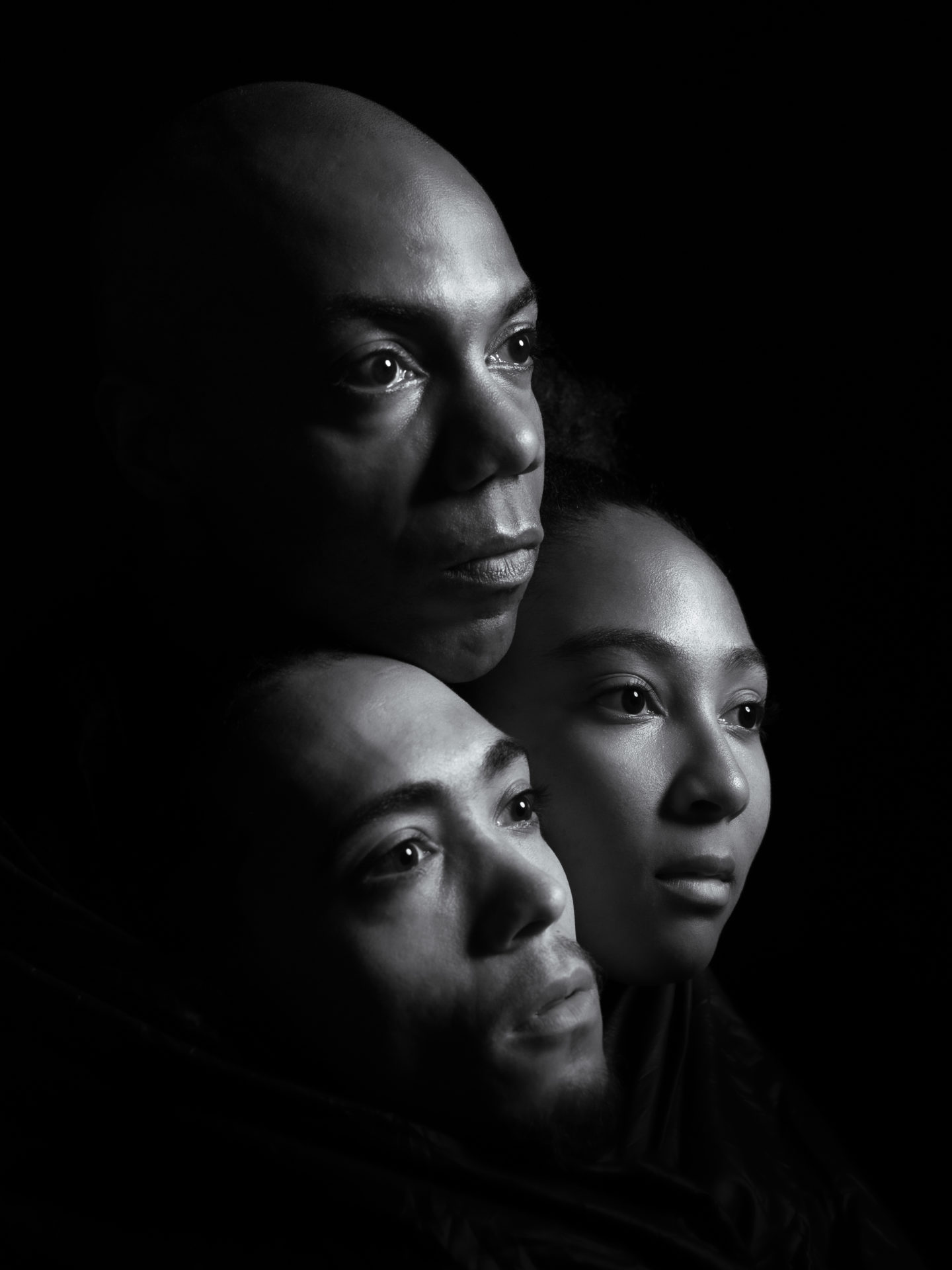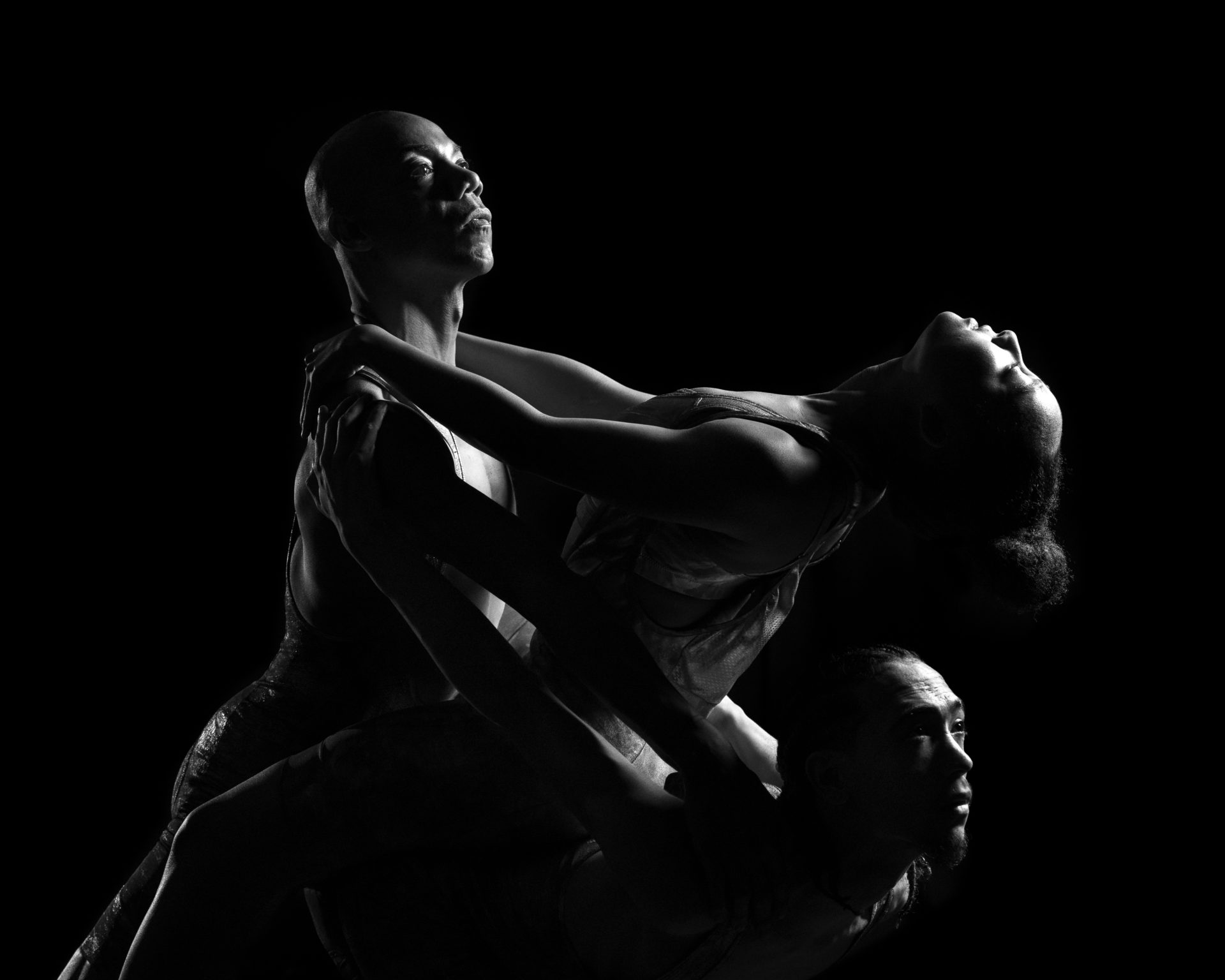OZ Arts presents
TRIBE – Black Hole: Trilogy and Triathlon
Darkened space, a throbbing mass of blue glimmering lights upstage center. Gradually, one by one, dancers emerge from a primordial ooze as if crawling into a new reality or allowing the audience an electron microscope’s view of a black hole’s inner life. Bronzed to emulate nudity, their bodies undulate like a human manifestation of ocean waves, their sinewy muscles urging us into an all-encompassing universe of three, a trinity of unity.

Choreographer Shamel Pitts, a Brooklyn-native, graduated from the Juilliard School, also studying at the Alvin Ailey School. Pitts has danced with companies directed by Mikhail Baryshnikov and Ohad Naharin and is the recipient of Guggenheim and New York Dance and Performance awards. “Black Hole,” the third and final section of Pitts’ Black Series, is part of his afrofuturist vision, which he does not see as a purely sci-fi or techno genre, but as “a philosophy of being…for artists of color to create new stories in which we are both the narrators and featured artists.” This part of the tryptych was “co-choreographed” and performed with Tushrik Fredricks and Ashley Pierre-Louis.
Born in South Africa, Fredricks has won prizes as dancer and choreographer in international competitions, such as the Stuttgart SoloTanz Festival. He has also worked with Sidra Bell <https://www.youtube.com/watch?v=W1hLjY9a27Y>, whose choreographic skills were last seen by local audiences in the February 2023 Nashville Ballet performances of *Anthology, *tales of Nashville history organized by Paul Vasterling*. *Pierre-Louis, also a dancer-choreographer, was trained in Florida. She freelances in New York and choreographed for *Help, *a play written by esteemed writer, Claudia Rankine.
“Black Hole” assimilates postures and movements from a variety of stylistic influences: *shirshasana* [headstand], *a**dho mukha svanasana* [downward dog], and *ardha purvottanasana* [crab] poses from yoga; rowing action and opening sprint poses from sports; running moves that resemble Michael Jackson moonwalking; and a brief bit reminiscent of a Soul Train dance line. But overall, the spirit of Japanese Nōh drama prevails in speeds like the *suriashi* step best described as glacially slow.

The slow movements, offset by brief sections of quickness, illuminate the exquisite body control all three dancers possess. Their lines are the epitome of physical beauty, creating the work’s sculptural architecture. They treat their trio of interweaving bodies as a singular unit, such as when their heads cluster together so closely that their necks embrace.
Much of modern dance emphasizes unusual use of the body and much of classical dance adheres to strict technical demands. Even in the *pas de deux *of classical ballet, the touch between the two dancers is limited, suggesting emotional distance, but TRIBE merges all these concepts into a natural mosaic of intimate proximity. Their seated rowing, for example, suggests the tight quarters of a slave ship, but the strength to survive adversity.
Dance, however, was only part of this one-hour, no-intermission* tour de force*. Pitts describes the series in Wagnerian terms as “contemporary Gesamtkunstwerk [that] combines dance, original sound, video projection, and light design.” The concept of an overarching artform constructed of diverse arts perfectly defines “Black Hole.” Music director Sivan Jacobovitz skillfully intermingles musics as different as Daniel Avery’s techno club music, Nina Simone’s blues, ChiHei Hatakeyama’s electronica, John Taverner’s neo-medieval “Funeral Canticle” and Sun Ra’s cosmic jazz, layered over dark ambient music. Mirelle Martin’s costuming with leotards and body paint casts the bodies as both anonymous and universal. Naomi Rapaport’s massive tarp, skillfully wielded by Pierre-Louis, and Lucca del Carlo’s phenomenal skill in lighting and video design enveloped the choreographic narrative with mystery and drama. This was particularly evident at the end where all the energy that we had witnessed was gradually re-absorbed into the darkness, into the void of the black hole.
Despite the fascinating lobby exhibits, the OZ setting was ill-suited for much of a performance whose choreography made constant use of bodies on the stage floor. The close seating with insufficient height for risers between rows resulted in heads bobbing and weaving, attempting to find a view of the dancers. However, bringing such visionary art to Nashville is to their everlasting credit.
For more information on Shamel Pitts and his works, see the MCR Interview
<https://www.youtube.com/watch?v=-b8A2PCC4q4&t=17s>.
- About the Author
- Latest Posts
Y Kendall is a Stanford-educated musicologist, specializing in dance history who recently earned an MFA in Creative Nonfiction at Columbia University, studying nonfiction writing with Ben Ratliff and Margo Jefferson. Kendall’s diverse works have been published in Alchemy: Journal of Translation, Columbia Journal, Mitos Magazín, The Hunger Mountain Review, and The Salt Collective, among others. Born and raised in Tennessee, Kendall now lives near Nashville, freelancing as a flutist and writer, while caregiving for relatives.



